Key Competencies Kit
for Facing Lifelong Learning


 |
This Project has been funded with support from the European Commission. This communication reflects the views only of the author, and the Commission can not be held responsible for any use which may be made of the information contained therein. |
 |
Didactic Unit 2 |
Theme |
Time |
Self motivation skills |
|
5 hours |
|
||
|
If you think about becoming self-employed, you are putting on the shoes of a business owner, an entrepreneur in its real sense. This is a responsible decision and to succeed as an entrepreneur you should objectively assess your entrepreneurship skills, personal strengths and weaknesses. The best way to do this is to perform self-analysis.
Self-analysis is analysis of one's own personality without the help of another
The ability to perform objective self-analysis is a powerful tool useful in many life situations.
Self-analysis can provide information that is accessible only to you. It also provides an occasion for you to examine your perception of your strengths and weaknesses using a lot of different personal information, thus, making analysis more full and grounded. Quality self-analysis may well provide the opportunity to turn weaknesses into strengths.
There is a universal technique for analysis called SWOT. SWOT is an abbreviation for Strengths, Weaknesses, Opportunities and Threats.
A SWOT analysis focuses on examining strengths and weaknesses in the internal environment and opportunities and threats in the external environment. The SWOT analysis to be structured like the table below:
SWOT analysis
I N T E R N A L |
Your |
Your |
E |
Opportunities |
Threats |
Strengths and weaknesses are Internal factors. For example, your strength could be clear vision of what kind of business you would like to start. A weakness could be insufficient entrepreneurship skills.
Opportunities and threats are external factors. For example, an opportunity could be your access to the Internet at a low cost that allows you to advertise your product or services cheap. A threat could be a new competitor in local market.
It is worth pointing out that personal SWOT analysis can be very subjective - two people rarely come-up with the same version of a SWOT analysis even when given the same information. Accordingly, SWOT analysis is best used as a guide and not a prescription.
Adding and weighting criteria to each factor increases the validity of the analysis.
Here is an example how SWOT analysis can look like.
I N T E R N A L |
Strengths |
Weaknesses |
E |
Opportunities |
Threats |


Here are some practical advices on how to perform your own SWOT
Explore your strengths. Avoid false modesty, but also be honest and realistic with yourself. Start out by simply making a list of words that describe you; chances are many of these characteristics comprising your strengths.
One of your greatest strengths can be love the work you do. Some people know from an early age what kind of work will make them happy.
In assessing your weaknesses, think about what and when you could improve upon.
Assessment of areas where we are weak helps to identify areas where we may need to improve.
Here is the list of critical questions answering which will help you with developing your entrepreneur SWOT analysis.
Strengths
Weaknesses
Opportunities
Threats
After you have analyzed your strengths, weaknesses, threats, and opportunities, you should use that information to formulate plan of action: what to and in what order to achieve the main goal – become an entrepreneur and start own business.
Your possible action plan consists of the following key steps:
Formulate SMART goals:
More about approaches to setting goals you can learn from Module 5 Learning to learn (didactic unit 2).
These goals should include two dimensions: business and your personal development (according to SWOT eliminating weaknesses and threats and utilising strengths and opportunities).

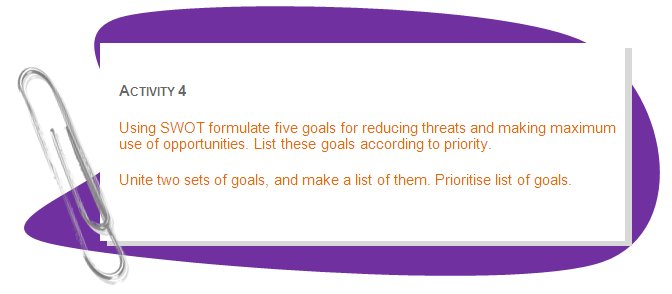
When you have prepared your SWOT analysis, the further work is to assess how the internal and external barriers can be coped with in a shorter or longer time perspective?
If you want that the list of goals will not remain on paper turn it into action plan.
Each goal should be turned into specific action programme that answer a number of questions, including: What will be done? How it will be done? When will it be done? Your key task here is setting specific timetables and deadlines for achieving goals by implementing mini action programmes.
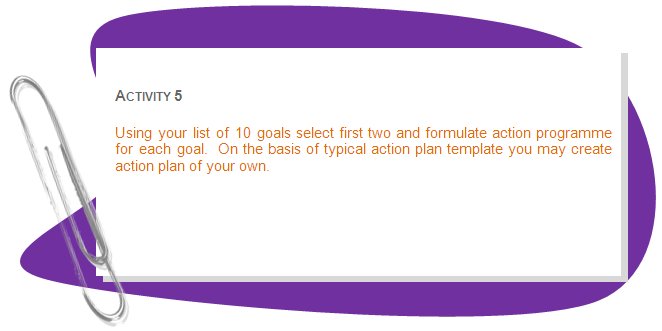
Action plan is not the same as simply writing out a "to do" list.
Your Action Plan
Whatever your goals, whatever stage you are at in the decision making process, you are most likely to make progress if you break down the tasks you have to do into small steps and then identify the actions you need to take for each step. Many action plans fail because the tasks appear too difficult. You may have several goals – but you need to break each down into a list of tasks. Set a timescale for each action – but be realistic – do not expect the impossible.
For each goal determine:
Example of a simple Action Plan
My Long Term Goal |
Short/Medium Term Goals to Achieving Long Term Goal |
Actions Required |
Constraints |
Who or What Can Help Me |
Deadline |
Improve transferable skills |
Improve time, management; communication skills and team working |
Attend informal training courses |
Not sure how to do this.
|
Talk to duty Careers Adviser. |
one mont
|
An action plan is more squarely focused on the outcome of each task and how it contributes toward the achievement of the major goal.
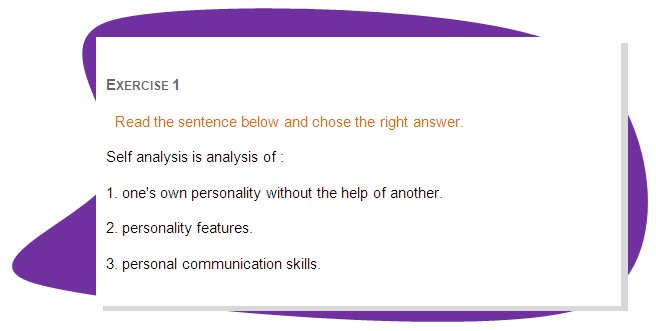
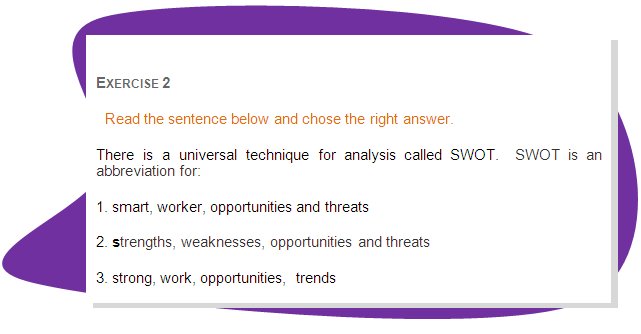
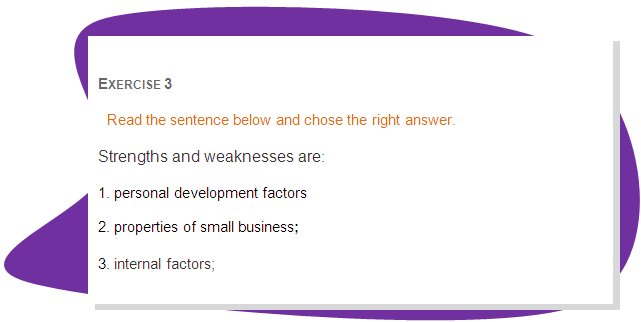
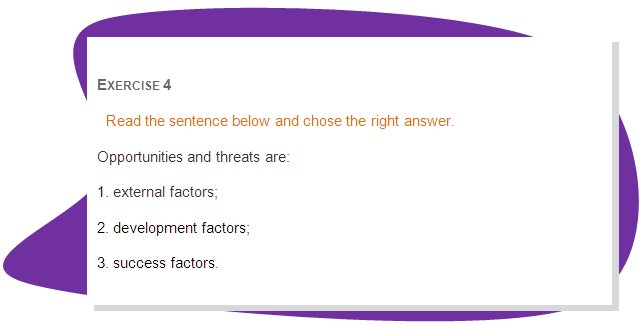
 |
Answers to the questions and exercises of Didactic Unit 2 |
1.
2.
3.
1.